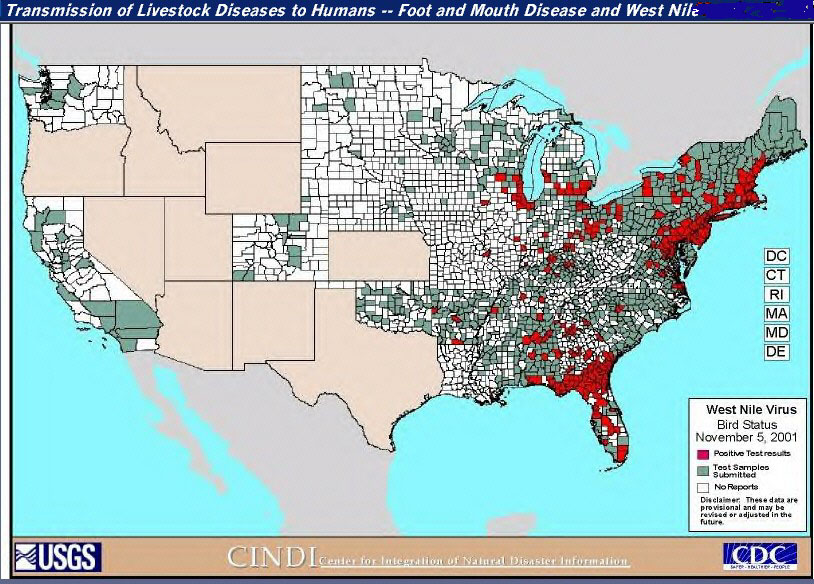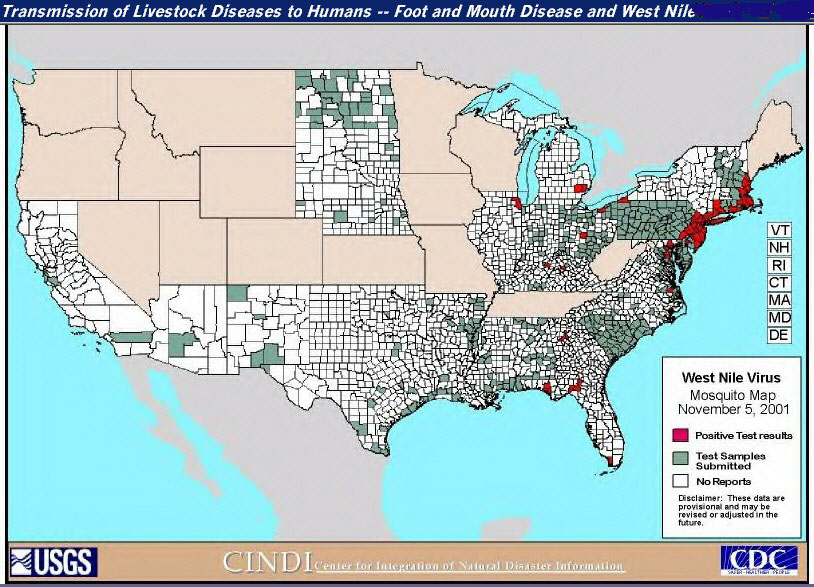

WEST NILE VIRUS
Questions and Answers About West Nile Virus -
http://www.cdc.gov/ncidod/dvbid/westnile/q&a.htm
Pennsylvania's West Nile Control Program. In 2000, West Nile virus appeared for the first time in Pennsylvania in birds, mosquitoes and a horse. ...
http://www.westnile.state.pa.us/
West Nile Virus
This section of National Biological Information Infrastructure (NBII) provides data, information, and maps related to outbreaks of the West Nile virus...
http://www.nbii.gov/issues/invasive/wnv/
West Nile Virus, US Geological Survey's Links Related to West Nile Virus: ... Outbreak of West Nile-like Viral Encephalitis - New York, 1999 (October 1, 1999). ...
http://www.usgs.gov/west_nile_virus.html
ERAP: What's Going on with
the West Nile Virus - Cornell ...
What's Going on with the WEST NILE VIRUS ... West Nile Virus Infection in the USA. 2002. WILDPro. Wildlife Information Network. ...
http://www.cfe.cornell.edu/erap/WNV/
West Nile Virus Surveillance Information - Bureau of Infectious Disease
...
West Nile (WN) virus was first isolated in 1937 from the blood of a patient in the province of West Nile, Uganda. ...Information about the disease and the efforts in Canada to detect it.
http://www.hc-sc.gc.ca/pphb-dgspsp/wnv-vwn/
Maps Showing West Nile Virus Distribution 2000 - The National Atlas of the United States of America. National Atlas Logo.
http://nationalatlas.gov/virusmap.html
NPIC's West Nile Virus Homepage
Download and distribute NPIC's West Nile Virus & Mosquito Control Products Flyer! West Nile Virus Resource Guide Homepage.
http://npic.orst.edu/wnv/
By Jennifer Bremer
Iowa Farmer Today
Ottumwa veterinarian Tom Lopp gives a horse the first of two shots to protect it against the West Nile virus.
OTTUMWA — Veterinarians report a huge demand for West Nile vaccine as Iowa horse owners rush to protect their animals from the disease.
‘‘We’ve sold more than 2,500 doses of West Nile virus vaccine in the past few months,’’ says Ottumwa vet Tom Lopp.
The virus is naturally transmitted between birds and mosquitoes. People and horses can acquire an infection if bitten by infected mosquitoes. No human exposure has been reported in Iowa. Health officials are not sure if other animals can get the virus.
Lopp says the only protection from the virus is to vaccinate.
The U.S. Food and Drug Administration (FDA) has ap-proved the first national trial of a drug to treat West Nile virus in humans, which has infected more than 250 people in 12 states.
The FDA cleared the way Monday for a doctor at New York Hospital to see if interferon can lessen the symptoms and duration of the illness in infected patients.
Lopp said, ‘‘Since it is such a new virus there is no immunity to it and while some horses may get the virus, they might not get sick but most will.’’
West Nile first appeared in Iowa about a year ago, and as of Tuesday there were confirmed cases in 71 of the state’s 99 counties.
As of Tuesday, 35 horses were diagnosed with the virus. Eleven horses have been euthanized, said Machelle Shaffer, spokeswoman for the Iowa Department of Ag-riculture.
Horses testing positive for West Nile have been reported in Jasper, Sioux, Adair, Lee, Van Buren, Palo Alto, Sac, Sioux, O’Brien, Lyon, Johnson, Boone, Cedar, Chickasaw, Dickinson, Harrison, Mahaska, Plymouth, Winnebago and Wood-bury counties.
Six counties added to the list as of Tuesday had either a dead bird or an infected horse. They are Boone, Clay, Crawford, Lucas, Monona and Wayne.
‘‘West Nile virus is not a contagious disease and is not passed from horse to horse or horse to human so there is no need for a quarantine,’’ state veterinarian John Schiltz explains.
A report by the Iowa Depart-ment of Public Health says there is no evidence to suggest handling of birds or other infected animals transmits the virus.
Horses with the virus will have an altered mental status. They will be unsteady on their feet and may have tremors. Some will fall and won’t be able to get back up. Swelling of the brain is the main cause of these symptoms.
Lopp says the virus has many of the same symptoms as Eastern and Western equine encephalitis, which have been around for many years.
West Nile was first detected in the United States in 1999 and was identified during an outbreak in New York City. The virus has gradually moved west. It was detected in Eastern Iowa this past September in a crow.
The incubation period is 5 to 15 days after the mosquito bite.
A person infected with the virus most likely won’t show signs or symptoms, according to the report. Symptoms most likely would be mild cases, including fever, headache, body aches, lethargy and occasionally a skin rash on the chest, back and arms.
A blood test is done on suspect animals, which may take several days to confirm.
Lopp says there is no specific therapy for treating West Nile, but horses would be treated with antibiotics. Some horses might recover in days or weeks, but many will die. ‘‘We have not seen any horses with WNV (West Nile) yet in our practice, but we believe it’s only a matter of time,’’ he says.
Of the estimated 100,000 horses in Iowa, about half have been vaccinated. The vaccine must be given in two doses, with the second dose three to six weeks after the first. Foals as young as 3 months should be vaccinated. The vaccine costs $14.50 to $25 per dose.
Some areas of the state have had problems with availability of the vaccine. Earlier in the year, vets had to wait two to three weeks.
‘‘That’s why people should stay on top of viruses such as this, so they can get their animals vaccinated and have them protected in case there is a shortage of vaccine,’’ Lopp adds.